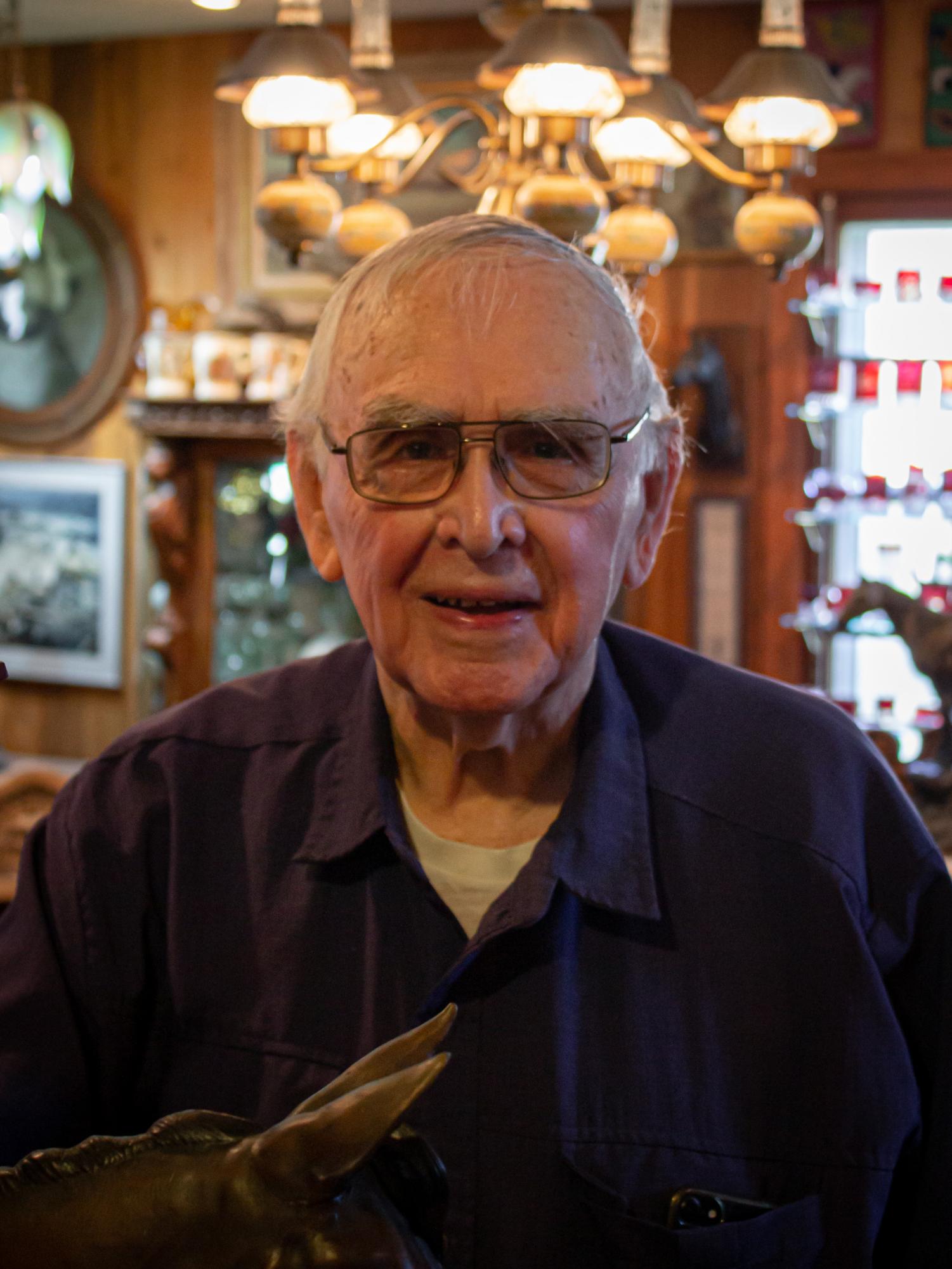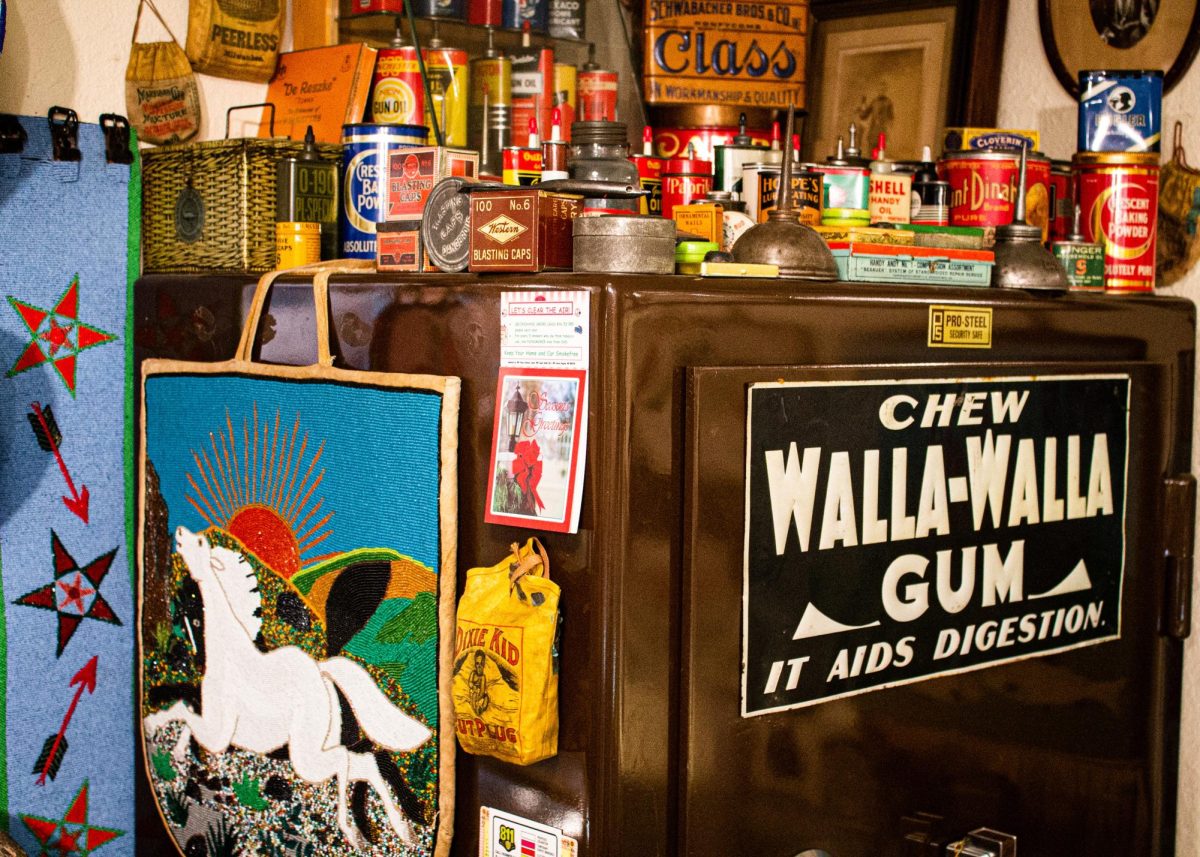In preservation of history: a look inside the home and collection of Fred L. Mitchell
In an outwardly unassuming house a few blocks from Whitman’s campus, a man with six decades of public service in Walla Walla keeps the largest collection of Plateau Native American beadwork ever amassed. And that’s only the beginning.
Fred L. Mitchell, Jr., is a retired firefighter, former Walla Walla mayor and current civil service commissioner. Walking into his house feels like entering a museum, for good reason: His beadwork collection has appeared in museums across the country, including a Tamastslikt Cultural Institute exhibit that the rest of the GENS storytelling community and I visited last semester.
When I first saw Mitchell’s beadwork collection at Tamastslikt, I was surprised and not a little confused by the prevalence of patriotic themes: Designs of bald eagles, billowing star-spangled banners and even George Washington on horseback. This is Mitchell’s favorite kind, in part because of the many histories its existence embodies.
“A lot of the Indians served in the wars and became patriotic, but they also were enterprising,” Mitchell said. “They made some of this material to sell, and patriotic was always high on the list.”
Mitchell’s patriotism as a Walla Wallan is seen in his accomplishments in city government.
“The development of the town pretty much happened when I was on council or mayor,” Mitchell said. “As mayor … the [Army] Corps of Engineers was going to Portland or Seattle, and that’s a lot of important jobs we would have lost.”
In the next room is a bronze sculpture called “Council Fire on the Columbia,” depicting Lewis and Clark shaking hands with Chief Yellepit at the mouth of the Walla Walla River. Like Mitchell’s beadwork collection, it’s a local piece, made by Walla Walla artist Dave Manuel, whose career was helped early on by Mitchell’s commissions. Behind it against the wall are several cradleboards, snowshoe-shaped baby-swaddling contraptions that many tribes still use today, although Mitchell only collects the old ones. Some of the cradleboards are accompanied by black-and-white photographs of children in them – Mitchell explains that he’ll sometimes acquire a cradleboard and later discover that his collection already has a photo of it, although it’s quite rare when that happens.
Mitchell leads me past a wall-mounted gavel from his time as mayor and into the Elk Room, where beaded bags hang from the antlers of an enormous elk head mounted on the wall – a trophy from a hunting trip 10 years ago. Mitchell goes for vertical display whenever he can: In his basement, mannequins in long black wigs display beadwork vests, and his arrowheads are pressed into foam plates, encased in glass and affixed to the rafters. Of everything Mitchell collects, the arrowheads are his oldest passion.
Mitchell’s childhood was filled with expeditions with his father to the Walla Walla and Snake Rivers. They spent much of their time fishing for sturgeon (among the many photos on Mitchell’s walls are snapshots of Fred Sr. and Jr., circa 1945, holding fish longer than their bodies), but even more was spent on the riverbank, looking for arrowheads. Mitchell found his first arrowhead when he was five years old, and since then has accumulated thousands, all carefully arranged into patterns in their frames. Some arrowheads are found and some are acquired from other collectors, but all are authentic and old.
“I’ve got paleo points [early stone hunting tools] that we found that are twelve to fifteen thousand years old. It gives you a special feeling when you find something like that. You think; the last human that handled it, what was his life like compared to ours? It makes you feel kind of insignificant … we’re just another grain of sand on the beach,” Mitchell said.
Everything Mitchell collects has a human connection. On one mantel is a row of handbells once used in one-room schoolhouses; many shelves feature ruby-flashed glassware, which travelers would mail home to loved ones.
“It represents a lot of good thoughts,” Mitchell said.
Where there isn’t glassware, one frequently finds antique kerosene lamps, which Mitchell likes because of the generations of children who did homework by them, and which he remembers using himself.
“When I first moved into this house 62 years ago, I lit one up in the living room, and my dad came up and said, ‘They gave a lot more light off when I was a kid.’ Well, they didn’t, but when that’s all you have, it seemed like it was a lot of light,” Mitchell said.
Mitchell uses all the light he has: Lamps and glassware alike are positioned on windowsills for the sun to shine through them.
Upstairs, in addition to more glassware and lamps, Mitchell keeps tributes to bygone technologies. Stone crocks once used to store crops in the winter, home coffee grinders and butter churners, machines used in drugstores for slicing plug tobacco when it was sold by the inch in strips: Mitchell has several of all of them.
“You get one of something, and then you need two, and then three, and then who knows when it’s going to stop,” Mitchell said.
Next to one of the tobacco cutters sits an unopened fabric package of tobacco, whose label declares it to be “Always Fresh.” The tobacco manufacturers, regardless of their confidence in their product, could hardly have anticipated that Mitchell would put their slogan to such a test.
Mitchell points out ceramic ashtrays once used in cars, a set of Tarzan novels he bought when he was 10 – still with the dust jackets on them – and a larger-than-life statue of Nipper, the canine mascot of the RCA Victor phonograph company. But among these marvels are a few more sobering artifacts that Mitchell recognizes as mementos of tragedies.
Mitchell indicates a silk pillowcase with an intricate image of the USS Arizona, the vessel sunk in the attack on Pearl Harbor.
“Whoever sent that home was killed,” Mitchell said.
Displayed nearby is a banner from the USS Indianapolis, a cruiser used to transport the atomic bomb dropped on Hiroshima.
“It left [Tinian Naval Base] and headed for the Philippines,” Mitchell said. “And they lost radio contact, nobody ever checked up. It was torpedoed by a Japanese sub. Most of the sailors were eaten alive by sharks. A real tragedy … the war was over by the time they found the guys, because it was right after they dropped the atomic bombs.”
Mitchell doesn’t put the items that have tragedies attached front and center, but by preserving the soldiers’ valued belongings, he keeps their stories alive.
In Mitchell’s basement, also somewhat hidden from view, is his collection of fishing lures, which hangs from a mobile in the basement, in an alcove opposite from the mannequins. Mitchell explains that he and his father began looking for lures when arrowheads became scarce, just because they loved walking the beaches. Dozens of brightly colored lures adorn the mobile, with hundreds more in cast-iron tubs beneath it.
“There’s thousands of hours in the walking,” Mitchell said.
Mitchell places strict limits on the beadwork in his collection – any additions must be of Plateau origin and made before 1945 – but his antiques are as varied as any museum collection. In one display is a walrus tusk from Alaska, with intricate patterns and illustrations carved into it by Native peoples in a process called scrimshawing. Across from it is an adze originally from the tropical Pacific Ocean. The glassware upstairs comes from world’s fairs all over the country.
Mitchell’s collection contains weapons – swords and rifles from the Revolutionary and Civil and Spanish-American Wars –but none are displayed prominently. Some are in a glass case by the stairwell, obscured by antique milk bottles filled with Styrofoam; others are suspended from the ceiling, repurposed as rails for beadwork bags to hang from.
“I don’t want it to be about guns,” Mitchell said.
However, he’s not trying to erase or forget any of the origins of the objects he collects. Many of his beadwork items feature swastikas, owing to their usage as symbols of good luck prior to World War II, although the change in meaning since then is far from ignored.
“I’ve got some Nazi stuff … brought back by [American] soldiers … I want [people] to be able to tell history like it happened … It needs to be recognized that there were Nazis, and if you’re smart enough to know about them, you’re not going to have them again,” Mitchell said.
Mitchell’s curation acknowledges the ugly side of history without celebrating it. In his basement display, the original intention of the swastika embroiderers comes through.
At the end of the interview, the photographer asks if she can take a picture of the collector himself.
“If you want to break your camera,” Mitchell said.
Even though his home is full of priceless objects, he’s not a materialistic person at all.
“The nice thing about collecting, or anything you’re involved in, [is that] you take trips you would have never taken, you meet people you would have never met, and it just adds a lot to life,” Mitchell said.










